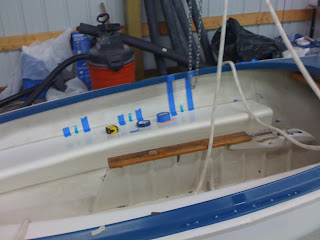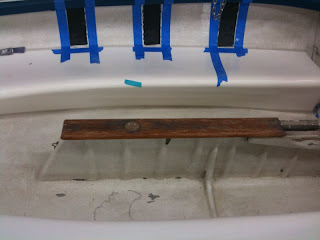Ok, so it's not a very creative title, but trust me; this has been the most exciting achievement on my boat so far!
What an accomplishment! If you're willing to do all the moving, sanding, and prepping required, and know a friend who will spray paint for beer, this adventure can cost as little as... $33.17!
Alright, I could have attempted the painting with a little instruction, but it was good to have a friend who was confident and experienced operating the paint gun. Rrrright then, pictures.

Ok, first off, I did sand the boat four more times. Twice with 120 grit. It's very important to note, that I finished the sanding with 2 rounds of 220 grit! Not 120!!
Having the right grit is important. It depends on the paint you use as well as the method, spray vs. Rolling. However, too fine a grit will inhibit the paint and keep it from adhering properly. Too coarse a grit will leave you with a streaky result. In my case, 220 was an optimum compromise.

Sanded and cleaned with acetone.

There he goes...




Two coats later and she's done. Wow, as I said before, this is very exciting!


What a result!

Ok, not to paint on the philosophy here, but it is very important to FINISH boat work. This coating will make the boat as slick as a day-old fish carcass on a slip'n slide, but it won't matter at all if I get an over early, miss a shift, or mess up my roll-tacks. My motivation is high to refurbish this boat, because I need to have it complete and sailing if Lisa and I are to get the practice on the water that is so very essential to any success in regattas.
Next, I make foils and reinforce the deck. Stay tuned, and please, leave comments!











.jpg)
.jpg)
.jpg)
.jpg)
.jpg) This process is not finished. We need to manufacture supports and bond them on as well.
This process is not finished. We need to manufacture supports and bond them on as well..jpg)
 Its an excellent barrier coat, performs like a primer, and sets up very very hard. If not wet-sanded in hull applications within 3 days, it becomes an absolute chore.
Its an excellent barrier coat, performs like a primer, and sets up very very hard. If not wet-sanded in hull applications within 3 days, it becomes an absolute chore. Gave it a good sand and applied first coat.
Gave it a good sand and applied first coat.

 Also, we put on the preventers for the shrouds using a Ronstan tang and some dyneema. Lisa did her first splice, beautiful eh?
Also, we put on the preventers for the shrouds using a Ronstan tang and some dyneema. Lisa did her first splice, beautiful eh?




























